

Impalement arts. Impalement arts are a type of performing art in which a performer plays the role of human target for a fellow performer who demonstrates accuracy skills in disciplines such as knife throwing and archery.

Impalement is actually what the performers endeavour to avoid - the thrower or marksman aims around the target rather than at him or her. The objective is to land the throw or shot as close as possible to the assistant's body without causing injury. Impalement arts are often found in circuses and sideshows as well as sometimes in variety, cabaret or burlesque shows. In addition, impalement acts have provided subject matter for literature, art, photography and film and television scripts. There are important distinctions between knife throwing or archery practised as competitive sports and similar skills displayed as impalement arts. Forms and variations[edit] Bill Pickett. Willie M.
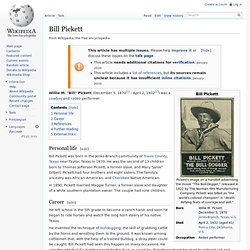
"Bill" Pickett (December 5, 1870[1] - April 2, 1932[2]) was a cowboy and rodeo performer. Personal life[edit] Wild West Shows. Buffalo Bill's wild west and congress of rough riders of the world - Circus poster showing cowboys rounding up cattle and portrait of Col.
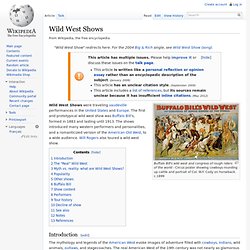
W.F. Cody on horseback. c.1899 Wild West Shows were traveling vaudeville performances in the United States and Europe. The first and prototypical wild west show was Buffalo Bill's, formed in 1883 and lasting until 1913. Bullwhip. Bullwhips are pastoral tools, traditionally used to control livestock in open country.
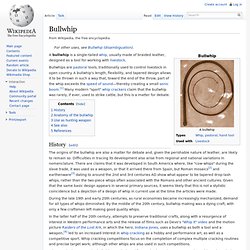
A bullwhip's length, flexibility, and tapered design allows it to be thrown in such a way that, toward the end of the throw, part of the whip exceeds the speed of sound—thereby creating a small sonic boom.[1] Many modern "sport" whip crackers claim that the bullwhip was rarely, if ever, used to strike cattle, but this is a matter for debate. History[edit] Lasso, Lariat, Trick Roping, Cowboy Fun, Western Arts, and Rodeo Skills. Please Read The Copyright Notice Next: Copyright by version 1.1July 8, 1996 The first draft of this book was written in 1989 and about 100 photocopies of it have since been distributed, mainly in workshops that I've taught at European juggling conventions.
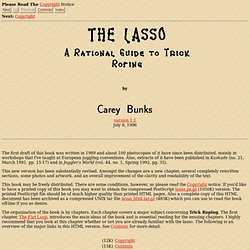
Also, extracts of it have been published in Kaskade (no. 21, March 1991, pp. 15-17) and in Juggler's World (vol. 44, no. 1, Spring 1992, pg. 35). This new version has been substantially revised. This book may be freely distributed. Trick roping. Trick roping is an entertainment or competitive art involving the spinning of a lasso or lariat.

It is particularly associated with wild west shows or western arts in the United States. The lasso is a well known-tool of American cowboys, who developed rope spinning and throwing skills in using lassos to catch animals. Cowboys developed various tricks to show off their prowess with the lasso and demonstrations of these tricks evolved into entertainment and competitive disciplines. There is a well-established repertoire of tricks that can be divided into three fundamental categories: "flat loop", "vertical loop" and "butterfly".
The Lady of Shalott. Overview[edit] Waterhouse's The Lady of Shalott Looking at Lancelot, 1894 The poem was loosely based on the Arthurian legend of Elaine of Astolat, as recounted in a thirteenth-century Italian novella titled Donna di Scalotta (No.

LXXXII in the collection Cento Novelle Antiche), with the earlier version being closer to the source material than the later.[1] Tennyson focused on the Lady's "isolation in the tower and her decision to participate in the living world, two subjects not even mentioned in Donna di Scalotta. "[2] Synopsis[edit] File:JWW TheLadyOfShallot 1888.jpg. The Lady of Shalott. Mabinogion. The Two Kings (sculptor Ivor Robert-Jones, 1984) near Harlech Castle, Wales.

Bendigeidfran carries the body of his nephew Gwern. The Mabinogion (Welsh pronunciation: [mabɪˈnɔɡjɔn]) is the title given to a collection of eleven prose stories collated from medieval Welsh manuscripts. The tales draw on pre-Christian Celtic mythology, international folktale motifs, and early medieval historical traditions. While some details may hark back to older Iron Age traditions, each of these tales is the product of a highly developed medieval Welsh narrative tradition, both oral and written. Le Morte d'Arthur. First published in 1485 by William Caxton, Le Morte d'Arthur is today perhaps the best-known work of Arthurian literature in English. Many modern Arthurian writers have used Malory as their principal source, including T. Idylls of the King.
Idylls of the King, published between 1859 and 1885, is a cycle of twelve narrative poems by the English poet Alfred, Lord Tennyson (1809–1892; Poet Laureate from 1850) which retells the legend of King Arthur, his knights, his love for Guinevere and her tragic betrayal of him, and the rise and fall of Arthur's kingdom.
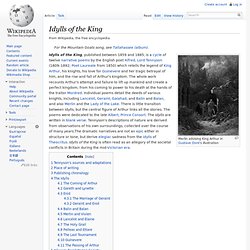
The whole work recounts Arthur's attempt and failure to lift up mankind and create a perfect kingdom, from his coming to power to his death at the hands of the traitor Mordred. Idylls of the King.